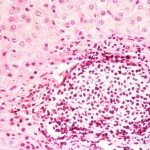Link to Pubmed [PMID] – 17505476
Mol. Ther. 2007 Aug;15(8):1452-62
Hepatitis C virus (HCV) infection is a major cause of chronic liver disease and hepatocellular carcinoma, yet fully efficacious treatments are missing. In this study, we investigated RNA interference (RNAi), a specific gene silencing process mediated by small interfering RNA (siRNA) duplexes, as an antiviral strategy against HCV. Synthetic siRNAs were designed to target conserved sequences of the HCV 5′ nontranslated region (NTR) located in a functional, stem-loop structured domain of the HCV internal ribosome entry site (IRES), which is crucial for initiation of polyprotein translation. Several siRNAs dramatically reduced or even abrogated the replication of selectable subgenomic HCV replicons upon cotransfection of human hepatoma cells with viral target and siRNAs, or upon transfection of cells supporting autonomous replication of HCV replicon with siRNAs. Importantly, three siRNAs also proved capable of strongly inhibiting virus production in cell culture. One siRNA, targeting a sequence that is highly conserved across all genotypes and forms a critical pseudoknot structure involved in translation, was identified as the most promising therapeutic candidate. These results indicate that the HCV life cycle can be efficiently blocked by using properly-designed siRNAs that target functionally important, highly conserved sequences of the HCV IRES. This finding offers a novel approach towards developing IRES-based antiviral treatment for chronic HCV infections.

